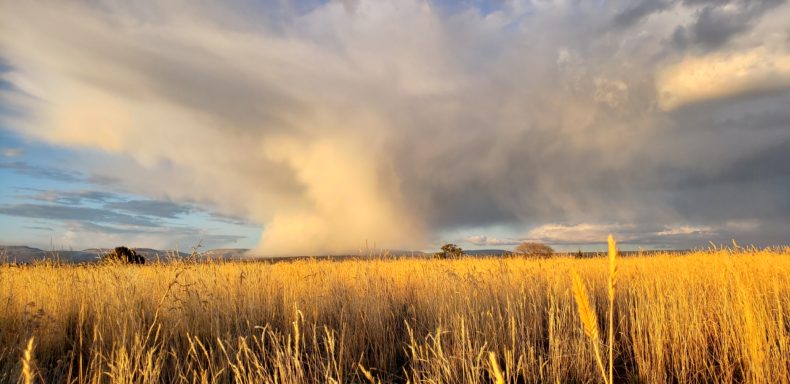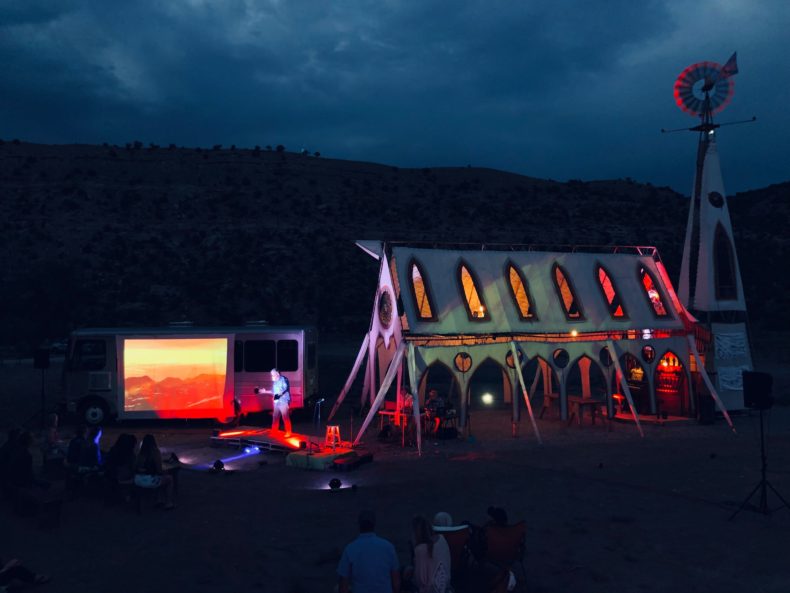
Over the last week I traveled from town to town in southwest Colorado giving stage performances at night, telling stories about being here at the height of summer, tales of drought and wildfires and raging thunderstorms. The moon and stars passed over our open-air venues. I gave the show some science and some mysticism, in my mind two sides of the same coin. I had a poet come out to read her version of a rain prayer, and she wore a flowing dress, her palms held to the sky. A crown of flowers in her hair was illuminated with tiny wire lights to get the attention of the clouds.
I won’t claim we had anything to do with it, but after several dry and rainless weeks, we started to see light showers on the days or nights of the shows. Lightning flashed and thunder rumbled across audiences.
I don’t know if prayer works, but it’s worth covering bases when it’s this dry. Getting clouds to come to us and drop their loads is no small or even possible task. Scientifically, there’s no way it could be true, based on something only in your head. Why would a cloud come toward you at your calling, then be convinced to disgorge its rain? In dry country, everything hangs by the taut string of precipitation. You imagine all sorts of things are possible.
One of our performance spaces was on a mesa top where we built a stage out of wooden pallets and brought in festoons of stage lights, a sound system, and images projected against a screen. As rain stories came up that night, drops began falling. I could see them through the stage lighting, silver streaks diving into a field of chairs and faces. I called to the rain as it fell, holding up my hands and feeling the cold sting, like diamonds poured from a freezer.

In her ethnology work at Zuni from the late 1800s, Matilda Coxe Stevenson described spirit beings, lightning people, thunder people, cloud people, each with its own identity, each part of making rain. She wrote, “The lightning people shoot their arrows to make it rain the harder, the smaller flashes coming from the bows of the children. The thunder people have human forms, with wings of knives, and by flapping these wings they make a great noise, thus frightening the cloud and lightning peoples into working the harder.”
Between shows last week, I was on the phone with Chris Lewis, an indigenous farmer and keeper of traditional stories and knowledge at the Pueblo of Zuni in northwest New Mexico. On a summer afternoon, temperatures sweltering into the low hundreds, Lewis at Zuni pointed out two lone clouds that I couldn’t see on the phone. “It’s really a bright blue sky,” he said. “There are two little clouds up there.” Lewis told me that he saw the clouds like people. One of them reminded him of his uncle. These two weren’t rain clouds. He said they weren’t the people who go to ceremonies and dances. They are loners, and he sees in the two clouds the kind of people who stay out at sheep camp and rarely come in to see anyone. The clouds are animate in his eyes. They have personalities and spirts. If you do it right, they can be appealed to.
Lewis reminded me that calling the rain is not just about noise as Stevenson documented at Zuni, but also about timing. He said if you start making noise before the rain begins, you might scare it off. Instead, you are quiet at first. Lewis’ eleven-year-old grandson has learned to come into the house if the clouds darken and he whispers to Lewis, “It’s coming.” Lewis puts a finger to his lips and they listen. If it starts to rain, he said, you can raise the volume. “At the dances, when it starts to rain, the drums go harder and the dance gets louder.”
If the rain slows, so do you, quieting until the last drops fall. In this way, you and the storm are doing the same thing. It is less calling the rain than welcoming it. Lewis said, “When the rain comes I say, oh, hello, you’re here, so nice to see that you came to visit!”
This tradition seems to be as much about asking for rain as greeting it, being at peace with its whims. Mysticism and animism may serve that purpose, aligning yourself with forces and elements around you, forming a personal relationship with them rather than an abstract one. The goal may be the same as science, having a rapport with the world. Lewis’ approach feels different from me getting up on stage and pounding, saying how much we need rain right now as wildfires burn and wells go dry. Maybe we’re covering our bases.
Cloud seeding is another form of prayer or conversation with the sky. Programs are in full swing in eight western states, adding up to $1.5 million of expenditures each year to coax precipitation out of the sky. Silver iodide seeded in the atmosphere forms nodes for moisture to latch onto, where they become heavy and fall. So far cloud seeding appears to be a variation on prayer, not sure if it’s really working, if snow packs and precipitation are truly increasing. One study found that over three days in Colorado, enough precipitation fell to fill 286 Olympic-size swimming pools, deemed the result of seeding. It’s a way of talking with clouds, forming a direct relationship.
It never rained hard at any of these shows. We had trash bags to cover the speakers and the sound board, but didn’t have to use them. If the storm turned into a downpour, I would not have wished for it to stop. You just don’t do that, especially during what is being called a mega-drought. You would never want the rain to stay away. Instead, the show went on. I felt like I was on my hands and knees begging for a drop, and sometimes, miraculously, by the push and pull of ions and wind, it came.
Sky photo by Craig Childs, venue photo by Ed Moss
Again, a lovely piece. I smile at the difference between two cultures. Your indigenous friend welcomes the rain. Cloud seeding forces it, possibly against its will. Who knows how the cloud people feel about this. I’ll try prayer. And I’ll wait for a cloud to ask.
Will you bring your show further west, please? We need all the help we can get!
Thoughts are creative. Prayer is a form of thought in my opinion. Congratulations for connecting with the water element. Enjoy watching your prayers answered.
Your words and observations highlight something important missing in our relationship with our Earth. Acting in accord with Nature, honoring that kinship and being a part of life living us, is right relation. Recognizing the true gift of being a part of this world brings us into better balance. It opens us to the richness of relating to a broadened vitality. Minding our manners brings forth a unified alliance, never experienced through dominance, due or demand.
We really miss out on the experience of rain when we treat it like only a symptom of weather.